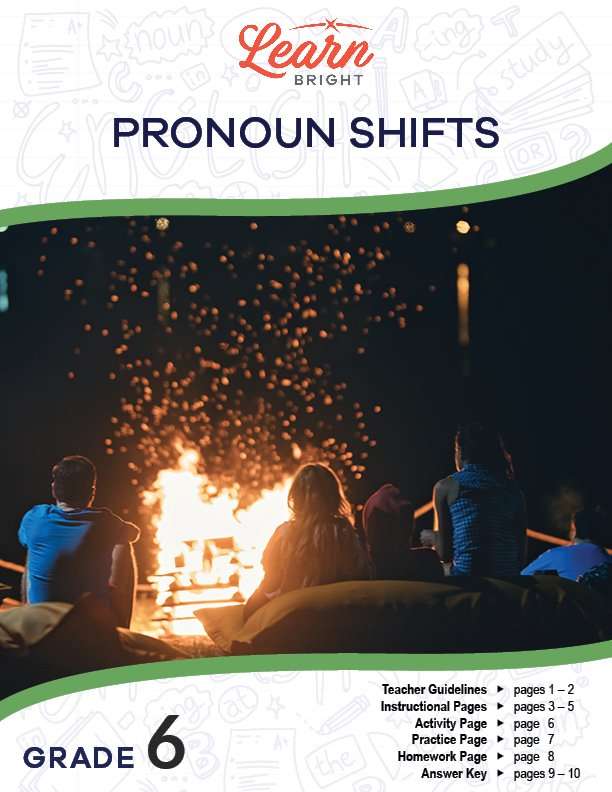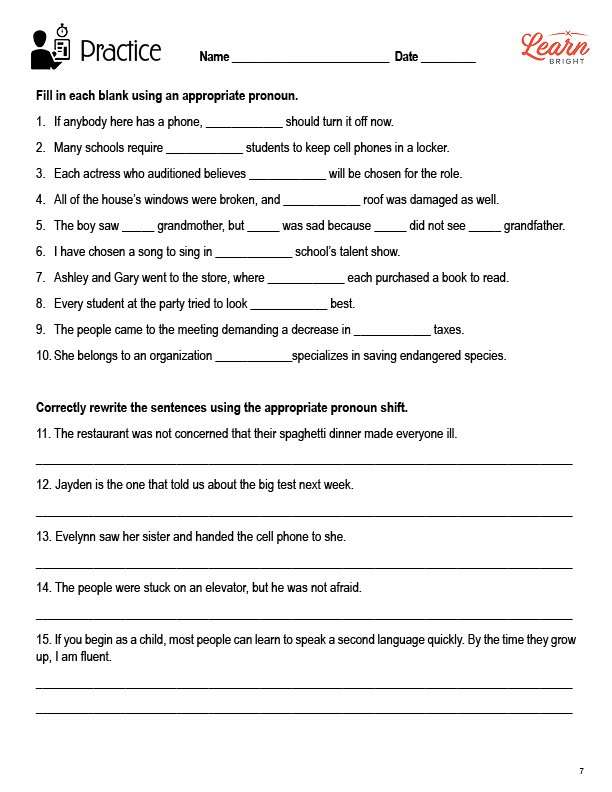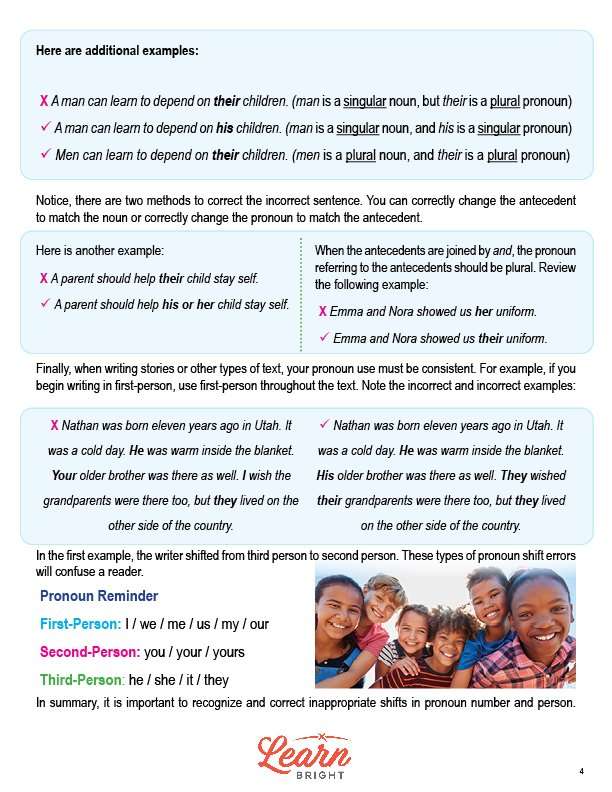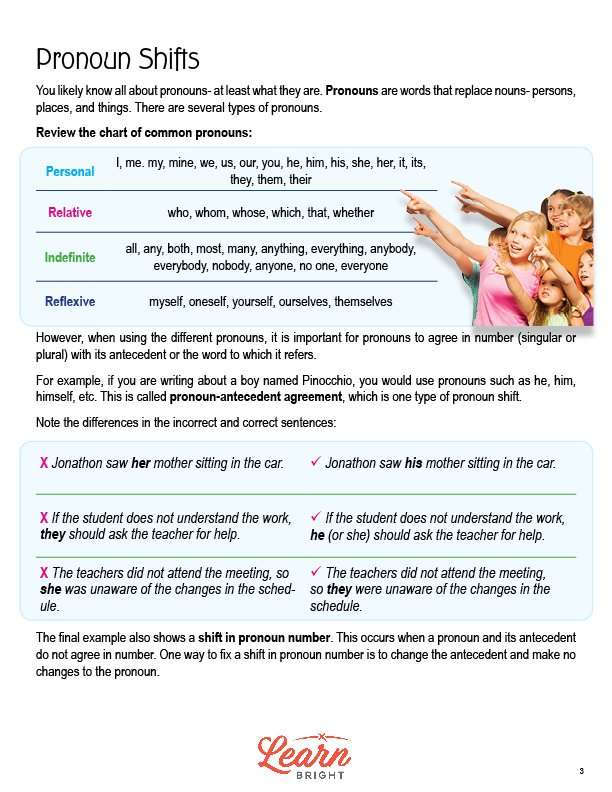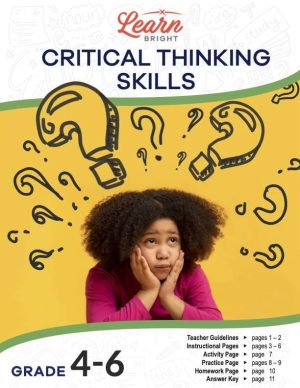Description
What our Pronoun Shifts lesson plan includes
Lesson Objectives and Overview: Pronoun Shifts teaches students how to use pronouns correctly and how to shift pronouns correctly. At the end of the lesson, students will be able to recognize and correct inappropriate shifts in pronoun number and person. This lesson is for students in 6th grade.
Classroom Procedure
Every lesson plan provides you with a classroom procedure page that outlines a step-by-step guide to follow. You do not have to follow the guide exactly. The guide helps you organize the lesson and details when to hand out worksheets. It also lists information in the green box that you might find useful. You will find the lesson objectives, state standards, and number of class sessions the lesson should take to complete in this area. In addition, it describes the supplies you will need as well as what and how you need to prepare beforehand. The only supplies you will need for this lesson are the handouts. To prepare for this lesson ahead of time, you can pair students for the activity and copy the handouts.
Options for Lesson
Included with this lesson is an “Options for Lesson” section that lists a number of suggestions for activities to add to the lesson or substitutions for the ones already in the lesson. The first adjustment is for the lesson activity, and suggests that you can increase or decrease the number of students will write. You can also have students use their current reading content and identify examples of correct pronoun shifts. Finally, you could have students write a four or five sentence paragraph where they switch from first to second to third person. Another student could then correct their paragraph.
Teacher Notes
The teacher notes page includes a paragraph with additional guidelines and things to think about as you begin to plan your lesson. It notes that it might be a good idea for you to teach this lesson in conjunction with other lessons related to pronouns. This page also includes lines that you can use to add your own notes as you’re preparing for this lesson.
PRONOUN SHIFTS LESSON PLAN CONTENT PAGES
Pronoun Shifts
The Pronoun Shifts lesson plan includes three pages of content. The lesson begins by stating that students most likely know what pronouns are already. Pronouns are words that replace nouns, or people, places, and things. Many types of pronouns exist. The lesson lists four common types of pronouns in a helpful chart that includes examples of each type. There are personal pronouns (I, me, mine, we), relative pronouns (who, whom, whose), indefinite pronouns (all, any, both, most), and reflexive pronouns (myself, oneself, yourself).
Pronouns must agree in number (singular or plural) with the antecendent (the word to which it refers). We call this pronoun-antecedent agreement, and it’s one kind of pronoun shift. The lesson provides some examples of both correct and incorrect sentences. One of the examples, which shows an incorrect pronoun (she) replacing the word teachers, is also an example of a shift in pronoun number. This means that a pronoun and its antecendent don’t agree in number. You can fix this by changing the antecendent so it matches the pronoun.
The lesson then includes more examples of this. It shows that the correct pronoun to match the singular noun man is the singular pronoun his, not the plural pronoun their. However, the plural noun men does agree with the plural pronoun their. These examples illustrate that there are two ways to fix the incorrect example: you can change either the antecedent to match the pronoun or change the pronoun to match the antecedent. The lesson includes another example of this as well.
You should make sure that, when writing a story or other text, your pronoun use is consistent. This means that if you begin a story in first person, you should use first person throughout. As a reminder, there are first person pronouns (I, we, me, us, my, our), second person pronouns (you, your, yours), and third person pronouns (he, she, it, they).
Students should make sure to be aware of the pronouns that they are using. They should be able to recognize inappropriate pronoun shifts in both number and person. Singular pronouns refer to one thing, while plural pronouns refer to multiple things. When writing, you should be consistent when using first, second, or third person.
PRONOUN SHIFTS LESSON PLAN WORKSHEETS
The Pronoun Shifts lesson plan includes three worksheets: an activity worksheet, a practice worksheet, and a homework assignment. You can refer to the guide on the classroom procedure page to determine when to hand out each worksheet.
INAPPROPRIATE PRONOUN SHIFTS ACTIVITY WORKSHEET
Students will work with a partner to complete this activity. They will work together to create five examples of inappropriate pronoun shifts, which they will then share with another pair of students. The second pair will then correct the errors. The original pair will also create an answer key with the corrected versions of the sentences. They will also correct another pair’s sentences.
Students may work either alone or in larger groups for this activity if you’d prefer.
APPROPRIATE PRONOUN PRACTICE WORKSHEET
For the practice worksheet, students will first fill in the blanks in ten sentences using an appropriate pronoun. Next, they will correctly rewrite five sentences using the appropriate pronoun shift.
PRONOUN SHIFTS HOMEWORK ASSIGNMENT
The homework assignment asks students to complete three short exercises. The first asks them to correct rewrite sentences using the appropriate pronoun shift. The second asks students to use specific pronouns (such as I and me) correctly in a sentence. The third exercise asks them to write a sentence that correctly uses as many pronouns as possible.
Worksheet Answer Keys
This lesson plan includes answer keys for the practice worksheet and the homework assignment. No answer key is provided for the activity worksheet, as students’ answers will vary. If you choose to administer the lesson pages to your students via PDF, you will need to save a new file that omits these pages. Otherwise, you can simply print out the applicable pages and keep these as reference for yourself when grading assignments.

